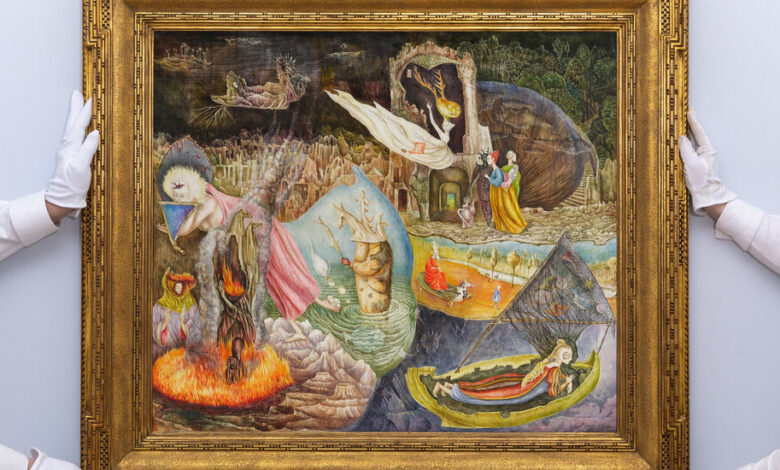Will the Art Market Find Its Footing After Stumbling Sales and a Hack at Christie’s?

Estimates are still soaring past the $20 million mark and canvases still bear the signatures of dependable ringers like Warhol, Basquiat and Picasso. But there is a shadow looming over the spring auction season that begins Monday.
A cyberattack at Christie’s brought down the company’s website on Thursday, and as of Sunday morning, Christie’s had not yet regained control of it, but promised the auctions would proceed, at least in person. (A place-holder website was set up allowing access to the digital catalogs, but did not allow online bidding.) With the site down and questions still unanswered about the fate of confidential data, analysts are uncertain about the impact on buyers and sellers.
Over the next week, more than 1,700 works of modern and contemporary art are expected to be offered at the three major houses — Sotheby’s, Christie’s and Phillips — with an estimate of $1.2 billion to $1.8 billion.
That represents a steep decline from the market’s most recent peak, in 2022, when the spring season generated an eye-watering $2.8 billion. But the bidding wars that characterized the pandemic spending frenzy have largely dissipated in favor of prearranged “guarantee” deals that assure paintings will sell for a minimum price. Young artists have also seen their secondary markets collapse as speculators exit the market. And a recent study by Bank of America Private Bank found that the average price of artworks sold at auction in 2023 decreased by 32 percent, the largest single-year decline in over seven years.
“There are all sorts of pointing fingers in the space, even among the auction houses,” said Drew Watson, who leads art services at Bank of America Private Bank. “The sentiment is pretty cautious. Either people are embracing more conservative estimates or deciding to sit on the sidelines to wait and see how things play over the next 12 months.”
Watson and others said that several factors have contributed to the market dip. Wars have preoccupied Russian and Middle Eastern collectors. A prolonged stretch of high inflation rates in the United States has created less liquidity on the financial side of the market. And the general lull in Asian buying, amid economic volatility and a property crisis in China, has resulted in a slowdown in modern and contemporary art auctions.
“There was a growth expectation that hasn’t fulfilled its promise in recent years,” Brooke Lampley, head of global fine art for Sotheby’s, said of the Asian market.
But she rejected the perception of a sluggish art trade, saying that her team was proud of the assembled evening sales. While previous seasons were buoyed by the nine-figure collections from the estates of patrons like the Microsoft co-founder Paul G. Allen ($1.6 billion, including day sales, cracking records at Christie’s) and Emily Fisher Landau (totaling $425 million last fall at Sotheby’s), this year’s auctions were put together lot by lot.
“We are pounding the pavement, regardless, to find the greatest works,” Lampley said, adding that the sales were built “with the appetite of today’s market very much in mind.”
For everyone else cautiously awaiting the auction results, here are six artists in the evening sales at Christie’s, Sotheby’s and Phillips to watch who experts say could test the art market’s strength.
Jean-Michel Basquiat
“Untitled (ELMAR)” (1982), $40-$60 million, Phillips Modern and Contemporary Art evening sale, May 14.
While many segments of the art market are softer than they were a few years ago, one artist remains as sought-after as ever: Jean-Michel Basquiat.
A nearly eight-foot-wide canvas by Basquiat, who died in 1988 at the age of 27, boasts the highest estimate of the spring season. “Untitled (ELMAR)” from 1982, which depicts a warrior shooting arrows at a falling angel, is expected to fetch between $40 million and $60 million at Phillips on May 14. (It carries a financial guarantee backed by a third party, meaning it is certain to sell.) The anthropologist and art collector Francesco Pellizzi bought the painting from Basquiat’s first dealer, Annina Nosei, and held onto it all his life. (Pellizzi died last year.) The work, along with two less valuable Basquiats, is being sold at Phillips by a trust affiliated with the collector’s family. In all, seven Basquiats (including one work the artist created with Andy Warhol) will be offered across the three houses’ evening sales this week.
“Untitled (ELMAR)” is one of some 200 paintings the prolific artist made in 1982, which collectors consider his best year. Basquiat’s auction revenue declined 46 percent in 2023 from its peak two years earlier, according to analysts at the Artnet Price Database. But experts attribute the drop to an absence of strong works coming to market, not a shift in demand. “The Basquiat market feels as strong as ever, although the array of works on the market this season will test it to the limit,” the art dealer Nick Maclean said.
Andy Warhol
“Flowers” (1964), $20–$30 million, at Christie’s 20th Century evening sale, May 16.
For nearly 40 years, the auction market’s health could be diagnosed by the rising and falling prices of Warhol paintings. So experts noticed last year when the evening sales failed to include any significant works by the Pop Art superstar. It was a shocking omission after he shattered the auction record for American artists in 2022 with the $195 million sale of a Marilyn Monroe portrait.
Christie’s is now offering a 1964 “Flowers” painting by Warhol with an estimate of between $20 million and $30 million on May 16. The work contains hand-painted petals and a provenance that includes a stay with a company named Search Investment Ltd., London, which acquired the painting from Thomas Ammann Fine Art in Zurich at some point before the 1990s.
Some analysts have noted that Warhol’s definitive early works are mostly held by museums, leaving iconic examples in short supply. There are dozens of flower paintings by the artist, which might have resulted in its current estimate. But with few other substantial Warhols available this season, the selling point might indicate the tolerance of collectors to dig a little deeper into the bench.
Leonora Carrington
“Les Distractions de Dagobert” (1945), $12–$18 million, Sotheby’s Modern evening auction, May 15.
Not every auction consignment begins with a collector looking to sell. Sometimes, it starts with an enterprising specialist who successfully persuades a collector that now is the time to part with a prized possession. That is the story behind “Les Distractions de Dagobert” (1945) by Leonora Carrington, the British-born Mexican painter and author, which carries an estimate of $12 million-$18 million at Sotheby’s on May 15.
Carrington — whose colorful life included several expulsions from school, estrangement from her family, and a stay at a psychiatric hospital — created this work when she was 28, soon after she moved to Mexico. The artist, who died in 2011, has been the subject of renewed interest as audiences re-evaluate female Surrealists. Carrington’s children’s book, “The Milk of Dreams,” inspired the title of the 2022 Venice Biennale.
The still-unknown seller bought the painting at auction in 1995 for $475,500 (or $974,500 today, accounting for inflation). Because the work carries a guarantee, it is certain to set a new benchmark for the artist. The current low estimate is more than triple Carrington’s top auction price of $3.3 million, set in 2022. That is a big jump. But Julian Dawes, Sotheby’s head of Impressionist and Modern art, said her works have sold for around $10 million privately.
Jeffrey Gibson
Two works, $40,000–$200,000, Sotheby’s Now evening auction, May 13, and Phillips Modern & Contemporary Art day sale, May 15.
Journalists and auctioneers are similar in one way: They both love a news peg.
Within the last year, Jeffrey Gibson has earned two of the highest honors in the contemporary art world. The Indigenous and queer artist has represented the United States at the Venice Biennale and was selected for one of the Metropolitan Museum of Art’s facade commissions. His first serious arrival into the evening sales comes with a 2015 beaded work called “Make Me Feel It” for a high estimate of $60,000 at Phillips and a 2014 figurative sculpture called “Always After Now” for a high estimate of $200,000 at Sotheby’s.
What makes these artworks noteworthy is not their appearance but their pricing, which seems to be far below the primary market, where one of Gibson’s iconic punching bags costs upward of $400,000. Going below the retail price is a strategic move by the auctioneers to encourage collectors into a bidding frenzy. But artists can suffer when that gamble fails at public auction, depressing their market and telling collectors who just purchased higher-priced works in the primary market that they got a bad deal.
“While we are transparent about retail prices for works in our exhibitions, we do not otherwise comment on the market,” said a spokesman for one of Gibson’s dealers, Sikkema Jenkins & Co.
Joan Mitchell
Paintings with a total estimate of $53 million, Sotheby’s Contemporary evening auction, May 13, and Christie’s 20th Century evening sale, May 16.
A record-breaking auction sale for an Abstract Expressionist star like Jackson Pollock ($61.2 million, set in 2021) or Mark Rothko ($86.9 million in 2012) might come around once a decade. But the top two prices ever paid for a Joan Mitchell at auction were recorded in as many weeks last fall — even as her results continue to trail behind her male peers. This season, Sotheby’s and Christie’s will try to keep up the momentum by offering six Mitchells across their evening sales. Together, they are estimated to command more than $53 million. The four works at Sotheby’s, which are guaranteed, are from the same American collector.
“It’s one of the few markets where we’ve seen repeatedly at auction prices go up and up,” said the art adviser Allan Schwartzman.
But is there enough demand to absorb all that Mitchell? Experts note that the artist’s output is so varied — from the frenetic, tangled compositions of the ’50s to the vibrant, brushy diptychs of the ’80s — that the offerings will appeal to different buyers. On the heels of a traveling retrospective and a popular show pairing Mitchell with Monet at the Fondation Louis Vuitton in 2022, the question is how many collectors will be willing to pay top dollar in the same week.
“The Joan Mitchell market is defining itself in real time,” Schwartzman said.
Ana Mendieta
“Untitled (Sandworm Series)” (1983), estimated at $300,000-$500,000, Christie’s Rosa de la Cruz evening sale, May 14.
The private museum that the Miami collector Rosa de la Cruz built through her purchases of contemporary art died alongside her. Earlier this year, the collector’s family closed the nonprofit and consigned more than two dozen artworks to Christie’s for a sale that was expected to make $30 million. That was a shock to some dealers who believed artworks they had placed with the Cuban-born de la Cruz were going to a permanent home.
“Our job as gallerists when we discover an artist is to place their work in the best possible hands,” said the dealer Marianne Boesky. “The de la Cruz collection was considered the best possible hands, and now it’s going to auction.”
What that means for collectors on May 14 is a rare chance to purchase works by artists who seldom appear on the secondary market. One of the most surprising is a 1983 sculpture by the Cuban American performance artist Ana Mendieta that carries a high estimate of $500,000, which more than doubles her high benchmark at auction. Will collectors want a sculpture from a performance artist? Has the popular podcast about her death introduced her work to new patrons?
Not everyone is confident the gamble will succeed. “Some works in the collection are not what the market is looking for,” said Watson, of the Bank of America. “The market wants blue-chip works and paintings by major postwar women artists.”
But those gambles are what makes the auctions so thrilling to watch.



